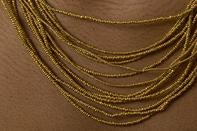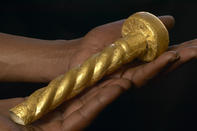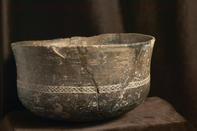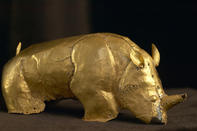Only a Fraction of Wealth
The University of Pretoria holds the majority of the artefacts found at Mapungubwe and K2, with a smaller collection held by Wits University. Sadly, this irreplaceable archive probably represents only a fraction of the original wealth of Mapungubwe.

Since the hill is so remote, it was difficult to police and many objects were looted from the site over the years. Rumours continually crop up of illicit gold in the hands of private collectors. A selection of objects from the University of Pretoria collection is now on permanent display at the Mapungubwe Museum, which is open to the public. The star attractions of the Mapungubwe Museum are the famous gold rhino, gold sceptre and gold bowl.
This trinity is at the heart of what Sian Tiley refers to as ‘South Africa’s Crown Jewels’. But the collection contains much more than that. Since gold is a soft, malleable and ductile metal, the people of Mapungubwe could heat it up and mould it into a variety of delicate forms. Gold sheeting was engraved to form beautiful decorations.
Thin sheets of gold foil were gently hammered around wooden bases to make wondrous objects that glinted in the sun. Beads were created by punching a tiny hole into a gold droplet. Hammered gold wire was wound into bracelets. Gold was fashioned into bangles and other geometric shapes to make desirable jewellery. All of these objects have a local origin and there is no evidence that any of the materials were cast.
Bead Crazy

As testament to this native African gold industry, the collection contains two incomplete gold rhinos, a number of gold animal torsos, thousands of tiny gold nails, the remains of a golden headrest and various other golden decorations.
Thousands of gold beads were found lying loose in the graves, but they would have originally been strung on cattle hair or fine plant fibre to make gorgeous, multi-stringed necklaces and bracelets. To give visitors an idea of how splendid these necklaces must have looked, the museum has painstakingly re-strung some of the beads. In addition to gold, the Mapungubwians were bead crazy!
The collection contains thousands of glass beads from all over the world; large composite ‘garden roller’ beads from K2; stone beads made from calcite and quartz; beads made from ostrich eggs; beads made from seashells and beads made from the shell of the terrestrial land snail. It is believed that beads were a sign of status, and different meanings were given to each colour.
White is thought to represent purity, black represents the ancestors, green is for fertility and so on. There are also a few cobalt blue beads that were highly prized throughout the region. As late as 1900, a farm worker said that one of these beads was worth £5 or one cow.
Gold and Other Metals

Ivory was the other major trade commodity. Most of ivory bangles, wrist bands and ornaments in the collection were found at K2, and never in large numbers. Seemingly, the royals did not fancy ivory for themselves and most of it was sent to the coast.
Although gold was only found on Mapungubwe Hill, the surrounding terraces yielded large quantities of less glamorous metal artefacts. There were the traditional iron hoes, arrowheads, spearheads, bangles, hooks, nails, chisels and blades common to many late iron age communities.
Spiked ingots made of copper, known by the Venda as musuku, were also found and are thought to have spiritual and commercial value. Several bronze items were collected, but are thought to have an exotic origin. There was probably a lot more stuff left behind when Mapungubwe was abandoned, but iron and copper tend to degrade much faster than gold.
Beautiful and Functional

Other objects in the collection include: delicate bone needles for sewing; bone hairpins; clay figurines of humans and animals (found mostly at K2); fragments of Chinese Celadon ware; ceramic bowls, spoons, whistles, jugs, pots, beakers and spindle whorls. The ceramics of K2 and Mapungubwe were usually used for cooking, drinking or storage.
Despite their functional purpose, these objects are often beautifully made in attractive shapes with intricate designs etched into the surface. They wouldn’t look out of place at an overpriced Afro-chic homeware emporium.
Crown Jewels Returned

In the past, there was no permanent display of the Mapungubwe treasures. Over the years, University of Pretoria had mounted over a dozen well-promoted public exhibitions that travelled around the country, but the public did not have free access to the collection. The demand for a museum became more apparent after 1994. Public interest in the collection grew exponentially with the new dispensation, and we had a desire to reclaim our history from the clutches of apartheid.
New symbols were sought which spoke of a proud African past. The people wanted to see the gold rhino! At the same time, several of the most important gold objects (including the rhino) had been sent to the British Museum for restoration. This process was expensive and time consuming, but the results were spectacular.
It would have been a shame to only bring it out for occasional exhibitions. Happily, after careful preparations, the Mapungubwe Museum opened its doors in 2000. It is located in the Old Arts Building on the main University of Pretoria campus in Pretoria. The ‘Crown Jewels’ had been returned to the people of South Africa.
By David Fleminger